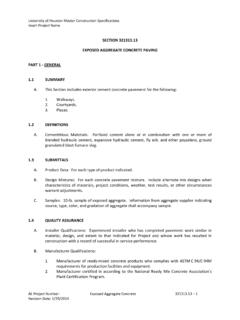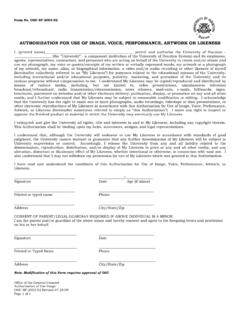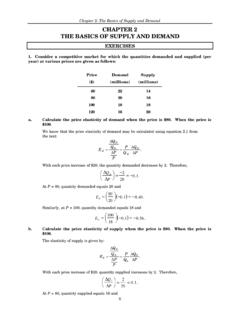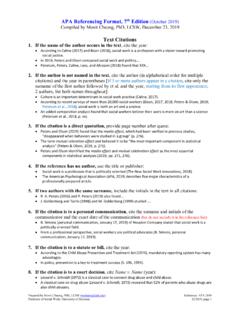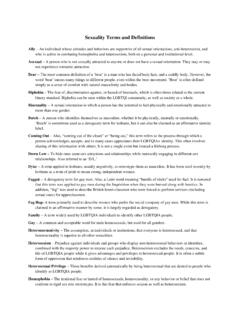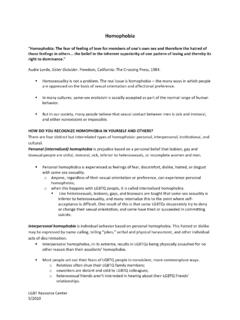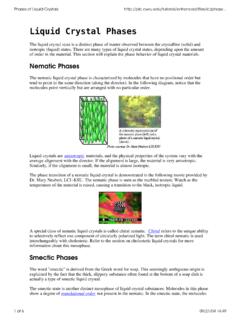Transcription of Introduction to Liquid Crystals - University of Houston
1 Introduction to Liquid CrystalsThe study of Liquid Crystals began in 1888 when an Austrian botanist named Friedrich Reinitzerobserved that a material known as cholesteryl benzoate had two distinct melting points. In hisexperiments, Reinitzer increased the temperature of a solid sample and watched the crystalchange into a hazy Liquid . As he increased the temperature further, the material changed againinto a clear, transparent Liquid . Because of this early work, Reinitzer is often credited withdiscovering a new phase of matter - the Liquid crystal Liquid crystal is a thermodynamic stable phase characterized by anisotropy of propertieswithout the existence of a three-dimensional crystal lattice, generally lying in the temperaturerange between the solid and isotropic Liquid phase, hence the term crystal materials are unique in their properties and uses.
2 As research into this fieldcontinues and as new applications are developed, Liquid Crystals will play an important role inmodern technology. This tutorial provides an Introduction to the science and applications ofthese are Liquid Crystals ? Liquid crystal materials generally have several common characteristics. Among these are a rod-like molecular structure, rigidness of the long axis, and strong dipole and/or easily polarizablesubstituents. A dipole is present when we have two equal electric or magnetic charges ofopposite sign, separated by a small distance. In the electric case, the dipole moment is given bythe product of one charge and the distance of separation.
3 Applies to charge and currentdistributions as well. In the electric case, a displacement of charge distribution produces a dipolemoment, as in a distinguishing characteristic of the Liquid crystalline state is the tendency of the molecules(mesogens) to point along a common axis, called the director (the molecular direction ofpreferred orientation in Liquid crystalline mesophases). This is in contrast to molecules in theliquid phase, which have no intrinsic order. In the solid state, molecules are highly ordered andhave little translational freedom. The characteristic orientational order of the Liquid crystal stateis between the traditional solid and Liquid phases and this is the origin of the term mesogenicstate, used synonymously with Liquid crystal state.
4 Note the average alignment of the moleculesfor each phase in the following mesogen is rigid rodlike or disclike molecules which are components of Liquid is sometimes difficult to determine whether a material is in a crystal or Liquid crystal materials demonstrate long range periodic order in three dimensions. By definition,an isotropic (Having properties that are the same regardless of the direction of measurement. Inthe isotropic state, all directions are indistinguishable from each other) Liquid has no orientationalorder. Substances that aren't as ordered as a solid, yet have some degree of alignment areproperly called Liquid Crystals .
5 The term crystallinity implies the presence of three-dimensional order on the level of atomicdimensions. In polymers, the range of order may be as small as about 2 nm in one (or more)crystallographic direction(s) and is usually below 50 nm in at least one direction. Polymercrystals frequently do not display the perfection that is usual for low-molecular mass Crystals that can be manipulated individually are often called polymer single quantify just how much order is present in a material, an order parameter (S) is defined. Sdescribes the orientational order of Liquid crystalline material, allowing for the individualorientational deviation of the molecules from the director, which represents the average over thecollection.
6 Typically, S ranges from to , depending on the temperature, with a value ofunity for perfect order. See Introduction to Liquid crystal phases section. Traditionally, the orderparameter is given as follows:where theta is the angle between the director and the long axis of each molecule. The bracketsdenote an average over all of the molecules in the sample. In an isotropic Liquid , the average ofthe cosine terms is zero, and therefore the order parameter is equal to zero. For a perfect crystal ,the order parameter evaluates to one. Typical values for the order parameter of a Liquid crystalrange between and , with the exact value a function of temperature, as a result of kineticmolecular motion.
7 This is illustrated below for a nematic Liquid crystal material .The tendency of the Liquid crystal molecules to point along the director leads to a conditionknown as anisotropy. This term means that the properties of a material depend on the direction inwhich they are measured. For example, it is easier to cut a piece of wood along the grain thanagainst it. The anisotropic nature of Liquid Crystals is responsible for the unique optical propertiesexploited by scientists and engineers in a variety of Liquid CrystalsThe following parameters describe the Liquid crystalline structure: Orientational order: Measure of the tendency of the molecules to align along the directoron a long-range basis.
8 Positional order: The extent to which the position of an average molecule or group ofmolecules shows translational symmetry. Bond orientational order: Describes a line joining the centers of nearest-neighbormolecules without requiring a regular spacing along that line. Thus, a relatively long-range order with respect to the line of centers but only short range positional order alongthat of these parameters describes the extent to which the Liquid crystal sample is order refers to the extent to which an average molecule or group of molecules showstranslational symmetry (as crystalline material shows).
9 Orientational order, as discussed above,represents a measure of the tendency of the molecules to align along the director on a long-rangebasis. Bond Orientational Order describes a line joining the centers of nearest-neighbormolecules without requiring a regular spacing along that line. Thus, a relatively long-range orderwith respect to the line of centers but only short range positional order along that line. Mostliquid crystal compounds exhibit polymorphism, or a condition where more than one phase isobserved in the Liquid crystalline state. The term mesophase is used to describe the "subphases"of Liquid crystal materials.
10 Mesophases are formed by changing the amount of order in thesample, either by imposing order in only one or two dimensions, or by allowing the molecules tohave a degree of translational motion. The following section describes the mesophases of liquidcrystals in greater crystal PhasesThe Liquid crystal state is a distinct phase of matter observed between the crystalline (solid) andisotropic ( Liquid ) states. There are many types of Liquid crystal states, depending upon theamount of order in the material. This section will explain the phase behavior of Liquid PhasesThe nematic Liquid crystal phase is characterized by molecules that have no positional order buttend to point in the same direction (along the director).
